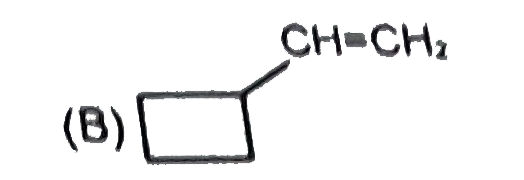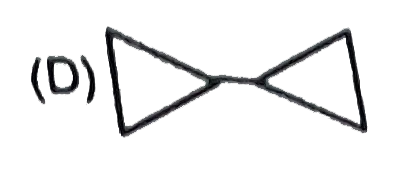A compound (X) with molecular C6H10 which shows Baeyer's test. Compound (X) can not be :


CH3−CH=CH−CH2−CH=CH2

To solve the problem, we need to analyze the compound (X) with the molecular formula C6H10 and determine which structure cannot undergo Baeyer's test. Baeyer's test is used to identify unsaturation in organic compounds, specifically alkenes and alkynes, through the reaction with cold, dilute potassium permanganate (KMnO4).
1. Identify the Structure of Compound (X):
- The molecular formula C6H10 indicates that the compound has unsaturation. The degree of unsaturation can be calculated using the formula:
Degree of Unsaturation=(2C+2−H)2
- For C6H10:
Degree of Unsaturation=(2×6+2−10)2=(12+2−10)2=42=2
- This means there are two degrees of unsaturation, which could be due to the presence of double bonds (alkenes) or triple bonds (alkynes).
2. Consider Possible Structures:
- Given the degree of unsaturation, we can consider various structures for C6H10. Some possible structures include:
- Alkenes (with one or more double bonds)
- Cycloalkenes (cyclic structures with double bonds)
- Alkynes (with triple bonds)
3. Understand Baeyer's Test:
- Baeyer's test involves the addition of KMnO4 to unsaturated compounds. If the compound has a double bond, it will react and the purple color of KMnO4 will disappear, indicating the presence of unsaturation.
4. Identify Which Structure Cannot Undergo Baeyer's Test:
- If a compound is fully saturated (no double or triple bonds), it will not react with KMnO4 and thus cannot undergo Baeyer's test.
- Among the possible structures of C6H10, if one of them is a fully saturated compound (like a cyclohexane derivative without any double bonds), it will not show a reaction with KMnO4.
5. Conclusion:
- Based on the analysis, the compound (X) that cannot undergo Baeyer's test is the one that does not contain any double or triple bonds. Therefore, the answer is the structure that is fully saturated.
Final Answer:
Compound (X) cannot be a fully saturated compound (like a cyclohexane derivative).
- The molecular formula C6H10 indicates that the compound has unsaturation. The degree of unsaturation can be calculated using the formula:
Degree of Unsaturation=(2C+2−H)2
- For C6H10:
Degree of Unsaturation=(2×6+2−10)2=(12+2−10)2=42=2
- This means there are two degrees of unsaturation, which could be due to the presence of double bonds (alkenes) or triple bonds (alkynes).
- Given the degree of unsaturation, we can consider various structures for C6H10. Some possible structures include:
- Alkenes (with one or more double bonds)
- Cycloalkenes (cyclic structures with double bonds)
- Alkynes (with triple bonds)
- Baeyer's test involves the addition of KMnO4 to unsaturated compounds. If the compound has a double bond, it will react and the purple color of KMnO4 will disappear, indicating the presence of unsaturation.
- If a compound is fully saturated (no double or triple bonds), it will not react with KMnO4 and thus cannot undergo Baeyer's test.
- Among the possible structures of C6H10, if one of them is a fully saturated compound (like a cyclohexane derivative without any double bonds), it will not show a reaction with KMnO4.
- Based on the analysis, the compound (X) that cannot undergo Baeyer's test is the one that does not contain any double or triple bonds. Therefore, the answer is the structure that is fully saturated.
Compound (X) cannot be a fully saturated compound (like a cyclohexane derivative).
Topper's Solved these Questions
Similar Questions
Knowledge Check
A compound X with the molecular formula , C3H8O can be oxidised to another compound Y whose molecular formula is C3H6O2. The compound X may be
Aprimary alcoholBsecondary alcoholCaldehydeDketoneA compound X with moleuclar formula C3H8O can be oxidized to a compoud Y with the molecular formula C3H6O2. X is most likely to be a:
ACH3CH2OCH3BCH3CH2CHOCCH3CH2CH2OHDCH3CHOHCH3
A compound with molecular formula C7H16 shows optical isomerism, the compound will be
View SolutionA compound (A) with molecular formula C5H10 gives one monochlorination product. Compound (A) is:
View SolutionThe structure of the compound with molecular formula C6H12 that has only 2∘ H atoms is:
View SolutionThe structure of the compound with molecular formula C6H12 that has only 1∘ and 2∘ H atoms is:
View SolutionA compound (X) with the molecular formula C3H8O can be oxidized to another (Y) whose molecular formula is C3H6O2
The compound (X) may be
View SolutionAn aromatic compound X with molecular formula C9H10O gives following chemical tests:
(i) Form 2,4-DNP derivative
(ii) Reduces Tollen's reagent
(iii) undergoes Cannizzaro's reaction
(iv) On vigorous oxidation 1, 2-Benzene dicarboxylic acid is obtained
The compound X is ,
View Solution
